23 Types of Bamboo to Spruce Up Your Yard & Garden
Author: Jen Worst | Editor: Omar Alonso
Review & Research: Jen Worst & Chris Miller
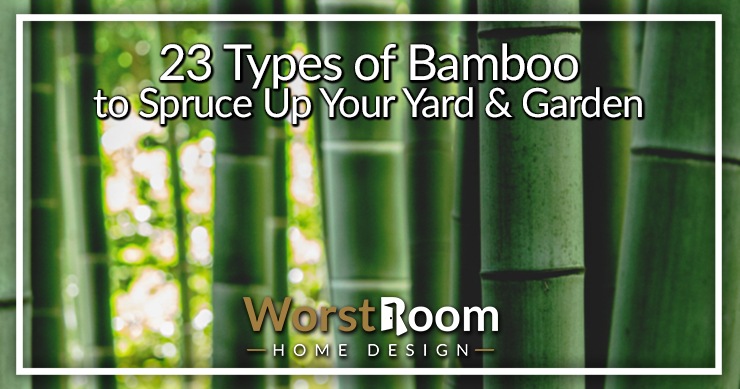
If you have a garden that needs a little more greenery, any of the types of bamboo will be a perfect fit. These plants grow quickly and serve as privacy screens or hedges among other uses.
But a lot of people are afraid of growing bamboo trees in their garden because some of them can be quite invasive if not contained.
The best way to get rid of that fear is to start by understanding that there are two types of bamboo trees. The clumping type does not grow invasively and once you plant them, you will realize that these are a rather wonderful addition to the garden.
23 Types of Bamboo
Here is a list of some of the types of bamboo plants. They're useful for more than just creating a beautiful yard or garden. They're used in all kinds of industries, even in types of blankets and even types of bowls. But growing them for our enjoyment is how we can honor them.
Buddha Belly Bamboo
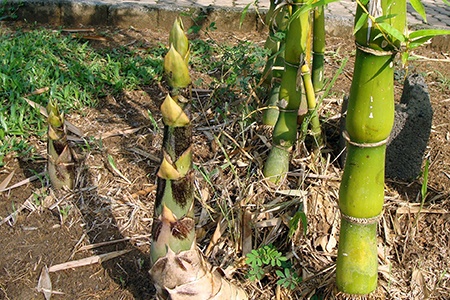
Scientifically called the Bambusa ventricosa, this variety is native to China and is named so because it has lumpy internodes that look like Buddha’s belly.
It is mostly an ornamental variety and grows well in fertile and well-draining soil. The bulges, however, can be exaggerated if not contained.
So, you must keep them without fertilizer or just grow them in dry soil. This is a tropical plant that needs full to partial sunlight to grow well. It can be grown in a temperate climate and can be kept indoors in cooler regions.
This is a non-invasive type of bamboo (meaning it is running bamboo) and can be used as a privacy screen. It grows up to 55 feet tall and has a decorative stem.
Slender Weavers
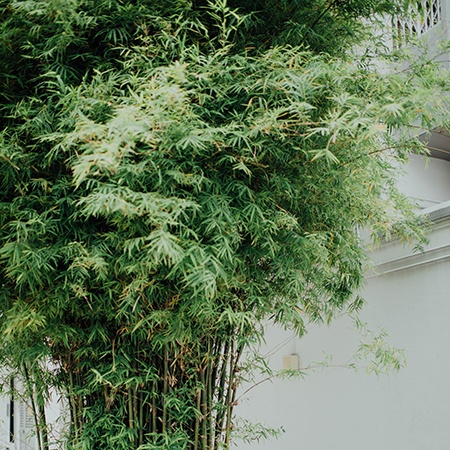
These are one of the most popular bamboo varieties and are scientifically identified as Bambusa textilis var. Gracilis. They have thin, tall and straight culms, which are the hollow stems of a plant that bear the flower, that look attractive. It's useful in creating a wattle fence for these reasons.
They grow quite quickly and also work well as a privacy screen or types of hedges. The clumps are likely to spread about six meters tall and 1.5 meters wide. So, you must plant them at a distance of one meter if you want them to form a dense wall.
Giant Bamboo
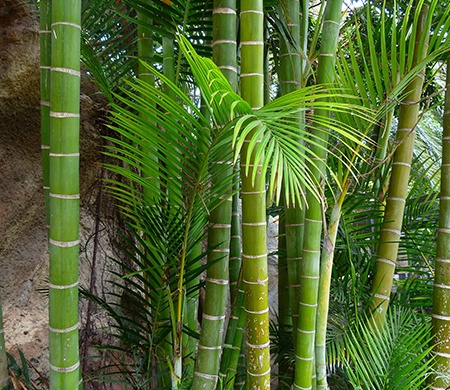
Its scientific name is Dendrocalamus giganteus and it grows up to 100 feet tall. This is the tallest type of bamboo that exists on earth and has chunky and sturdy culms.
Their circumference is about one foot and huge canes are one of their special features. These canes look chalky white in the beginning but as they mature, they start to look dark blue and pale green in color.
This variety of bamboo plants grow very quickly and their shoots grow up to 12 inches in one day and usually reach a height of up to 20 meters.
The giant types of bamboo plants need partial shade to full sun and you must maintain the moisture in the soil for them to grow well. Speaking of soil, it must be rich or well drained.
These plants are native to Thailand, Burma and China and are suitable only for large gardens. They flower only once every four decades and are great if you want to add privacy. They make great fence alternatives if all you care about is establishing a visual boundary.
Timor Black
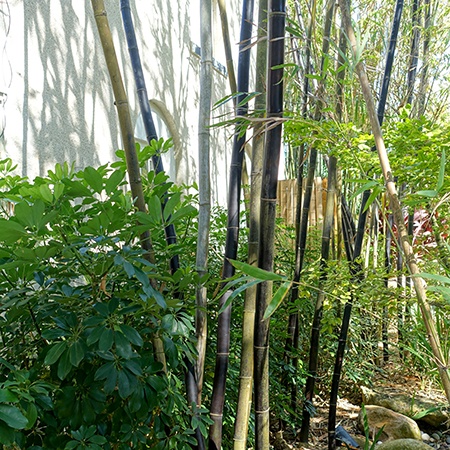
This is a favorite choice and is called so because it has a screen of glossy black culms and light green leaves. It is a good substitute for the running type of bamboo and is scientifically identified as Bambusa lako.
This variety should be grown in medium to large gardens and can be kept in planter beds if you can manage it. Typically, they grow to a height of 12 meters.
Umbrella Bamboo
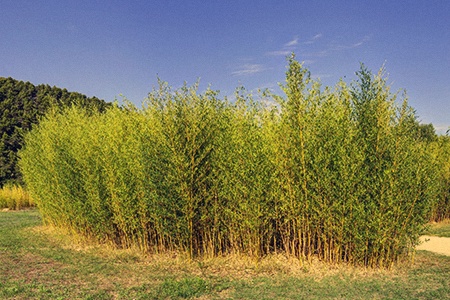
Scientifically called Fargesia murielae, the umbrella bamboo plants grow up to 15 feet tall and are a versatile variety. It is a hot favorite because it is non-invasive, elegant, sturdy and easy to care for.
It is also adaptable and has greenish-yellow canes with slender leaves. The leaves have a dainty look and are bright green on the top and a grayish-green on the bottom.
As they grow, you will find the canes to arc from the weight of the foliage but you do not need to snap them. This bamboo also grows quite quickly and spreads about four to five feet wide.
It tends to form a lot of clumps and grows well in partial shade. Placing it in direct sunlight causes the leaves to shrivel.
The soil must maintain moisture levels. So, get moisture-retentive soil for this bamboo type.
Dwarf Green Stripe
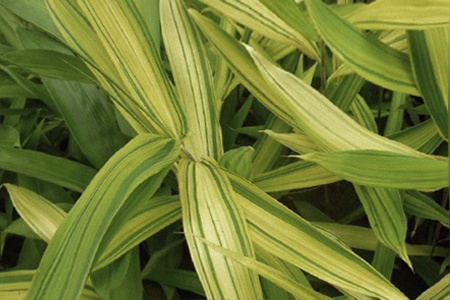
Scientifically called the Pleioblastus sp., this bamboo is a very good edging plant. It grows up to 500 mm and what it lacks in height is compensated for in its beauty.
This bamboo has striped yellow and green leaves that make it an excellent lush. It is of the running bamboo species, so you might want to keep an eye on it even though it is a low-growing variety.
Dragon Head Bamboo
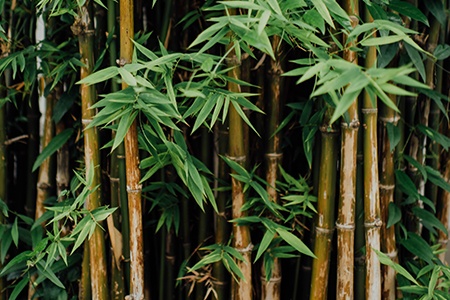
Hello, panda food. This one is the primary food source for the beloved black and white bears but is also a pretty-looking plant.
The canes are shiny green in color and the leaves are blue-green, narrow and glossy. The canes arch slightly because of the weight of the leaves because each of them is about four inches in length.
Scientifically called Fargesia rufa, these types of bamboo trees are native to China but are propagated in many other countries because all one needs to do is simply cut the stem cuttings. They grow up to eight feet tall and need full sun and partial shade.
Make sure that it is planted such that it stays away from the afternoon sun to avoid the intensity. The soil must be fertile, well draining and must maintain moisture. This is also an excellent way to create a privacy screen.
Chinese Fountain Bamboo
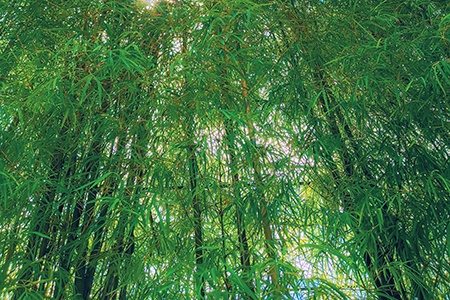
Speaking of bamboo from China, this elegant variety has long and slender canes that arch heavily because of the weight of the foliage.
The canes are in medium green color with patches of purple. They are also likely to form clumps of five feet. The leaves are a gray-green shade. They are long and narrow with a matte surface.
Scientifically called Fargesia nitida, this is one tough plant and can handle itself quite well in severe cold. But it is not a big fan of extreme heat.
This bamboo grows well in partial shade and needs less sunlight than the other bamboo varieties. And it gets better. This one can grow in any kind of soil from poorly draining to soggy.
That is why the Chinese fountain bamboo can grow near riverbanks, ponds and streams. It grows up to 15 feet in height.
China Gold
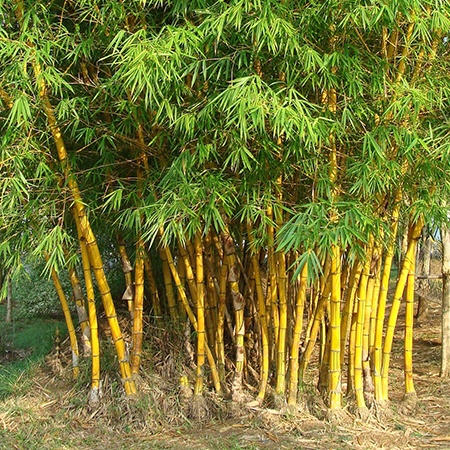
The next Chinese variety is an exquisite-looking bamboo that is scientifically called Bambusa eutuldoides var. viridi vittata and grows up to six meters tall. It has bright lemon-yellow culms that are marked by green striations.
The culms are heavily branched so this is another great type of bamboo to create a privacy screen. These bamboo types can serve a practical, objective purpose while still being gorgeous to look at.
And if you want to use it as a decorative object, you would want to prune the lower part of the tree and show off the golden canes.
Chinese Dwarf
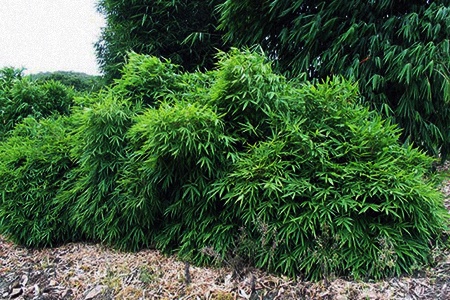
This is a bushy bamboo variety with the botanical name Bambusa guangxiensis. It is a compact plant that grows up to three meters tall and is a good option for a small privacy screen. You can also grow it in a pot or make it a garden bed.
It is lush at the bottom towards the ground and looks quite elegant. But if you are going for looks, you can remove the lower branches.
Goldstripe Bamboo
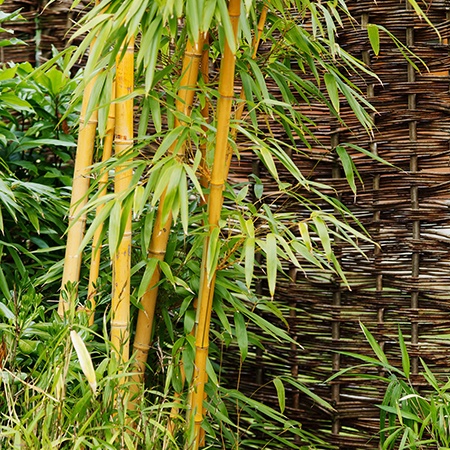
These types of bamboo trees have lovely looking green and gold strips and is a great variety of clumping bamboo. Scientifically called the Babusa Goldstripe, this is good for a compact and upright privacy screen.
It even grows in narrow beds that are only 40 centimeters in width. They typically grow up to three to four meters tall and must be planted at least one meter wide so that the culms can comfortably reveal themselves.
Fish Pole Bamboo
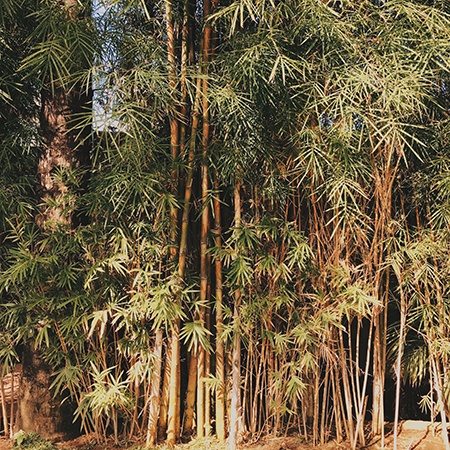
This one is called Phyllostachys aurea and grows up to 25 feet in height and 15 feet in width. It has smooth, straight canes and is called fish pole bamboo because it has evergreen canes that are initially in bright medium green but grow into a pale yellow-green color.
This plant grows well in full sun to partial shade and must be watered to maintain moist soil. The soil itself must be well drained and when done right, this bamboo is quite tolerant of heat and drought.
The canes of this plant are tough and sturdy. They do not arch under the weight of foliage and grow vigorously. In dry conditions, fish pole bamboo will grow clumps and in moist soil and warm temperatures, it can become invasive if not contained.
It is originally from China where the canes are used in the making of umbrella handles and walking sticks.
Moso Bamboo
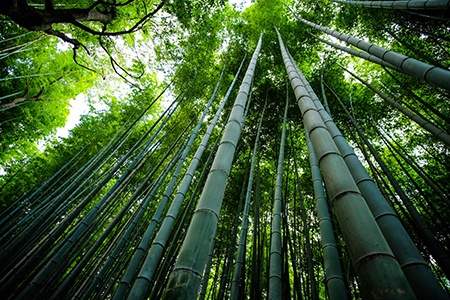
Moso bamboo species are scientifically known as Phyllostachys edulis. If it's able to grow in soil that keeps a constant level of moisture and receives full to partial shade, it can grow to gargantuan sizes of up to 60 feet tall.
You can identify it more easily by the soft covering of hair growing up the cane. The mature cane takes on an orange-to-yellow color, though it starts out dark green. The shoots themselves can grow up to 8 inches in width, making this more like a full blown tree.
Green-Glaucous Bamboo
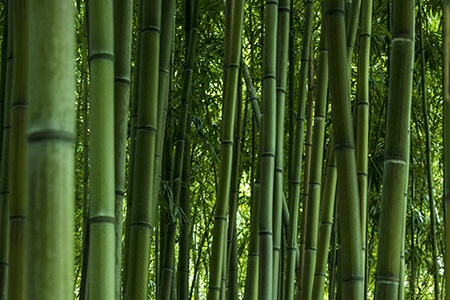
Green-Glaucous bamboo is known by the name Phyllostachys viridiglaucescens. It grows in the USDA Hardiness Zones between 6 and 11. With the prime conditions of moist but well-draining soil, these types of bamboo plants can grow up to 30 feet in height.
You'll enjoy the added visual details of its culms that develop stripes as it matures into it's yellowish green color. These grow very dense and can form a nice living fence without additional work.
Hedge Bamboo
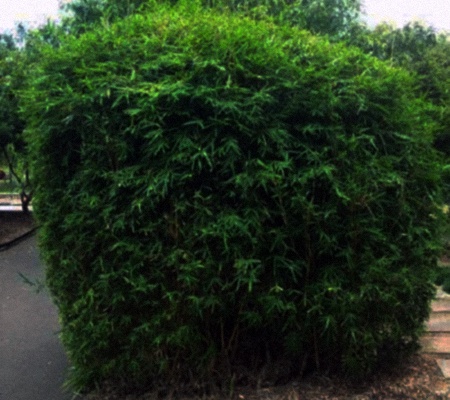
Hedge bamboo is known to scientists as Phyllostachys glauca. If you live in the USDA Hardiness Zones of 7-10, this is a great choice for you if you can provide them with full sun, because they're very tolerant to drought. That means if it doesn't rain often enough, you don't need to worry about watering them.
The younger plants will have a blueish gray powder along the culms, but this is lost as the canes mature and take on their turquoise, bright green colors. The canes only grow to about two inches in width, creating a very wispy, romantic forest that blows in the wind. These are wonderful types of bamboo for landscaping.
Black Bamboo
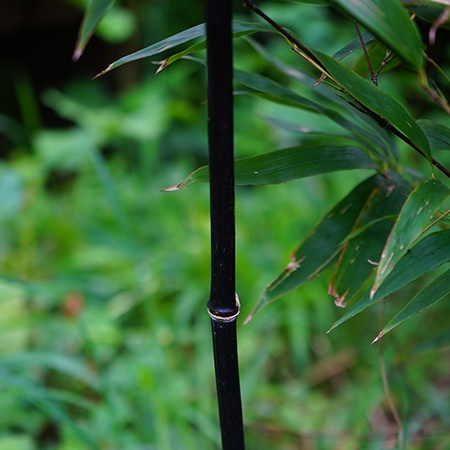
This bamboo species is known by the name of Phyllostachys nigra, black bamboo derives its name from the canes that start as an olive green color and phase through brown all the way to a black color by years two to three. It's an interesting contrast to the foilage, because the leaves remain green.
It's such an interesting juxtaposition of colors that the Royal Horticultural Society gave it the Award of Garden Merit. If you're looking for fence ideas, these can make a great privacy fence since they grow so dense.
Watch out that you don't let them get out of hand because they can become invasive and spread relatively quickly.
Painted Bamboo
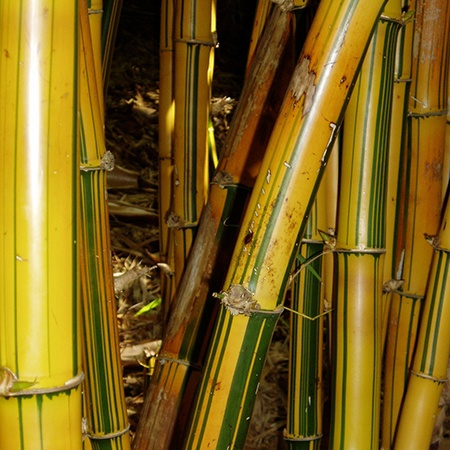
Painted bamboo goes by the name Bambusa vulgaris. This ornamental bamboo is treasured for the vertical stripes on the gold colored canes. The stripes are generally dark green and will flow out from the nodes at various widths.
These types of bamboo can grow up to 60 feet tall at max, and generally falls between 40 to 60 feet. The leaves stay narrow and grow up to 7 inches in length. The root system is vast and can really help with erosion control.
Guadua Bamboo
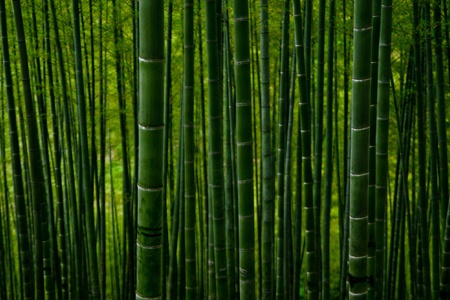
Guadua bamboo is from the neotropical genus found in Uruguay and is known as one of the thorny bamboo types. You'll find this growing in Trinidad, Northern Mexico, and even across the Amazon, preferring areas of lower elevation.
It's used as a material for building houses along the Ecuadorian riverbanks, and contributes to the wildlife ecosystem as a food source. You probably won't choose this for your lawn or garden, but it's important to mention.
Japanese Timber Bamboo
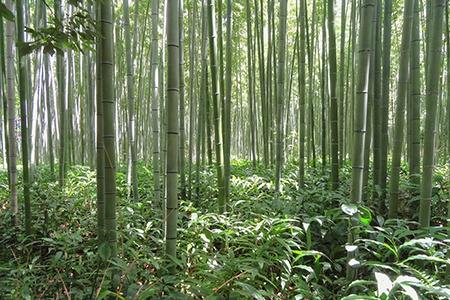
Phyllostachys bambusoides, the scientific name for Japanese timber bamboo, is grown primarily to be harvested for timber. The cultivation isn't difficult, and it will grow as tall as 70 feet, making it very valuable for industries. It's sometimes called Japanese Cane Bamboo.
Funnily, this bamboo is native to and comes from China, so the name is strange but it's how it worked out. They start out an emerald green color and become yellowed over time. They'll grow so tall and heavy that the canes will start to arch under the weight.
Japanese Arrow Bamboo
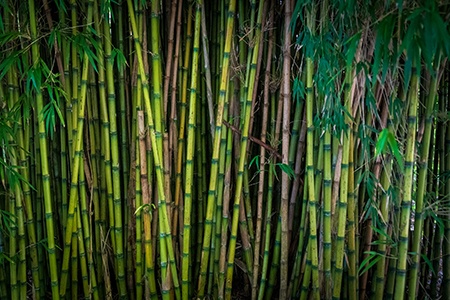
It's assumed that the name of this bamboo comes from Japanese samurai using the cane to make arrows. It's native to areas of Japan like Kyushu and Honshu but also grows well in South Korea. In the United States it grows well in hardiness zones 6 through 10.
The canes are very stiff and sturdy, helping it withstand low temperatures and complete or partial shade. The yellow-brown leaves can grow up to 13 inches in length. You can even grow these in containers. If you live near the ocean, it can even handle the salt in the air.
Chilean Bamboo
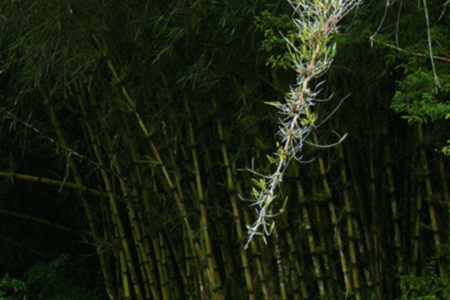
Chilean bamboo belongs to the Poaceae family of grass. It's an evergreen that grows in South America, especially and obviously Chile. It can withstand cold temperatures and even frost, as well as the heat of Argentina.
These bamboo types can bloom for up to 60 years if its allowed to survive that long. The leaves grow a hair lanceolate, which means it'll have a spine growing on the ends. They grow in such a way as to regulate each other from over-growth.
River Cane Bamboo
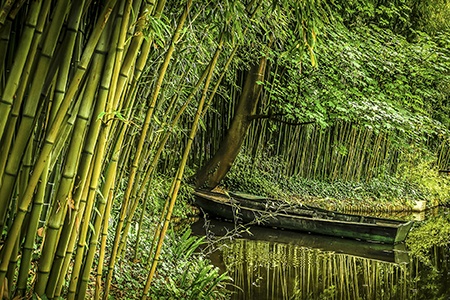
Known as Arundinaria gigantea, you'll hear it referred to by common names such as River Cane and Giant Cane. It grows well in and is native to states such as Texas, Maryland, and Oklahoma. This switch cane plant thrives in wet habitats.
This perennial bamboo can grow up to 33 feet high and has uses in many industries, even historically in basketry. Native Americans used it in all areas of their lives in the past.
Fargesia Bamboo
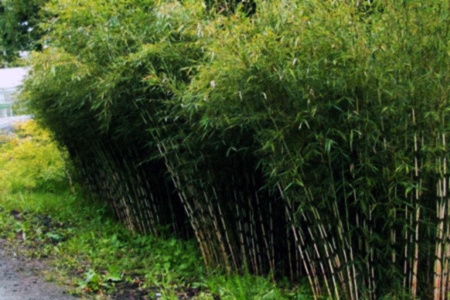
Fargesia bamboo is a clumping bamboo native to China but grows as far out as the Himalayas and Vietnam. It's wildly cultivated as an ornamental plant and sold under names such as Fountain bamboo or Umbrella bamboo.
The name comes from an honor given to Père Paul Guillaume Farges. It's considered one of the hardiest bamboos, and despite that it's not an invasive species at all. You've likely seen video or images of it being eaten by giant pandas.
Types of Bamboo for Every Climate
Oriental, tropical or modernist, your garden could use a little bamboo magic. But as mentioned in the beginning, you must pick the right variety.
It is important to remember that while they look like trees, bamboos are perennially classified as plants from the grass family. A lot of gardening enthusiasts use them as decorative plants because these types of bamboo grow fast and look really pretty.



